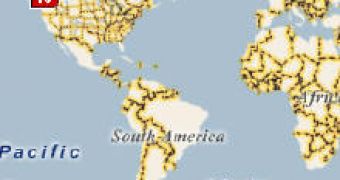Microsoft today announced beta availability of MSN Virtual Earth, with which users search, discover, explore, plan and share information and activities relevant to specific U.S. locations by combining aerial imagery, detailed maps and precise local search capabilities. Users can access the beta version of the servicehere .
The new Microsoft Location Finder is a separate client-side application based on technology developed by Microsoft Research. It operates seamlessly with MSN Virtual Earth and turns a regular Wi-Fi-enabled laptop, tablet or PC into a location-determining device without the addition of any separate hardware. When the Locate Me link in MSN Virtual Earth is clicked, Microsoft Location Finder is activated and uses Wi-Fi access points to determine the user's location. Next, the user's present location is centered on the map, enabling him or her to quickly and easily search that area. Microsoft Location Finder can be downloaded free when a user initially clicks on the Locate Me link, or at http://virtualearth.msn.com/?autolocate=true.
Microsoft is also providing free access to the MSN Virtual Earth map control, in the form of an easy-to-use JavaScript control, for technology developers and others who want to incorporate noncommercial uses of MSN Virtual Earth into their own applications and Web sites.
Virtual Earth Features
MSN Virtual Earth features include the following:
- Aerial photo with labels. This navigation feature combines real-world imaging with the usefulness of a traditional road map by letting people see aerial photos with an overlay of road networks and point-of-interest information. - Locate Me. With this feature consumers can quickly find their present location, then explore and discover the area around them. The Locate Me link activates Microsoft Location Finder, which uses Wi-Fi access points or Internet Protocol address geocoding to determine a person's location. - Scratch Pad. As people conduct searches around a location, they can choose to save search results including name, address and description as a list or itinerary to the Scratch Pad. This provides users with a simple way to compile search results that can be e-mailed, copied into a document or even added to a weblog on MSN Spaces. - Permalink. Permalink is for consumers who regularly conduct the same searches or who want to share specific searches with others. By clicking the Permalink link, a URL is created that then can be used to return to MSN Virtual Earth later and re-create map view and searches. The Permalink link can be bookmarked, e-mailed to a friend or copied into a clipboard. - Yellow page directories. MSN Virtual Earth incorporates licensed yellow page directories to enable users to find high-quality yellow page listings. These directories have been incorporated into the MSN Search index so users can query the information in broad, flexible ways. - Zoom, panning and compass controls. Users have multiple options for navigating their view of aerial photos or standard maps in MSN Virtual Earth; they can use the mouse's scroll wheel, zoom, or Game Panning via the Compass Control. - Community link. A Community link in the navigation bar calls up a Web site that encourages people's feedback and enables their participation in the ongoing development of MSN Virtual Earth. - Developer resource center. Accessible from the Community site as well as directly from http://www.viavirtualearth.com/ , the developer resource center is a third-party Web site from which developers can download the MSN Virtual Earth map control and find other information to help them start creating Web sites that incorporate the MSN Virtual Earth service.
In the next beta release of MSN Virtual Earth scheduled for later this year, MSN plans to incorporate oblique, or bird's-eye, imagery licensed from Pictometry International Corp. that depicts cities, landmarks and points of interest at a 45-degree-angle view.

 14 DAY TRIAL //
14 DAY TRIAL //